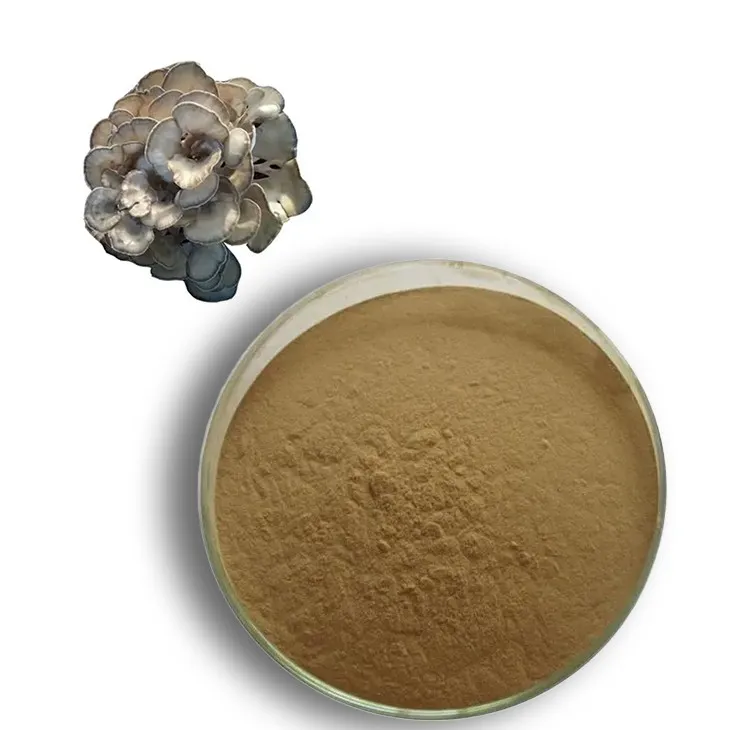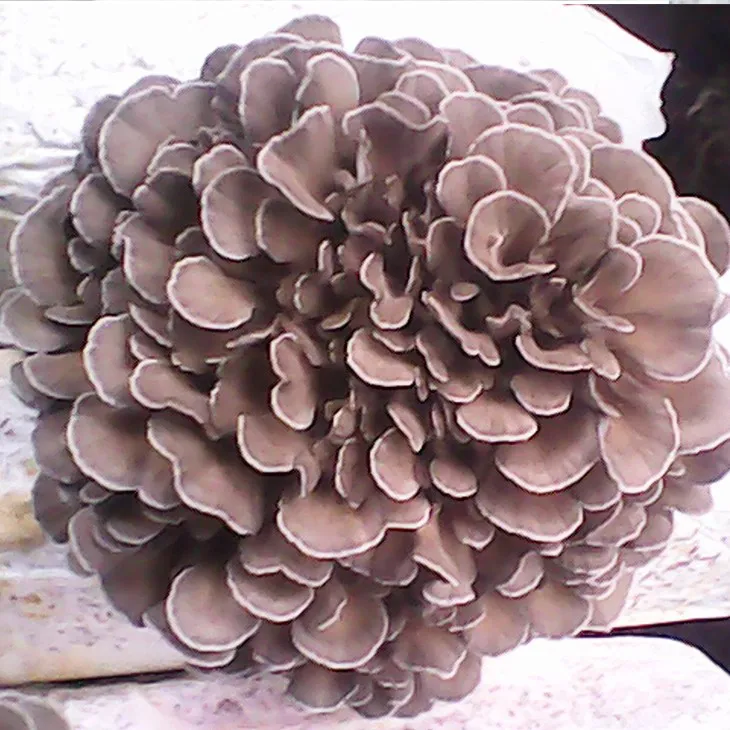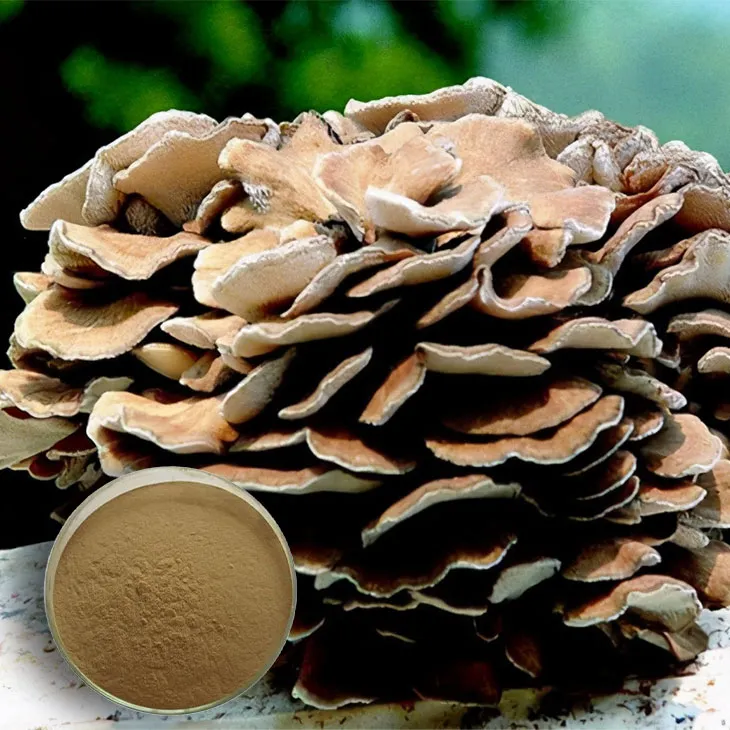- 0086-571-85302990
- sales@greenskybio.com
Supercritical Carbon Dioxide Extraction of Maitake Mushroom Extract.
2024-11-29

1. Introduction
Maitake, a well - known mushroom, has been the focus of extensive research in recent years due to its rich reservoir of bioactive substances. These bioactive components have the potential to offer various health benefits, making maitake a valuable source for the development of functional products. Supercritical carbon dioxide extraction has emerged as a leading - edge technology in the extraction of maitake extract, presenting numerous advantages over traditional extraction methods.

2. Maitake Mushroom: A Treasure Trove of Bioactive Substances
Maitake (Grifola frondosa) is a large, polypore mushroom that grows at the base of trees, mainly in certain regions of Asia, Europe, and North America. It contains a wide range of bioactive compounds, such as:
- Polysaccharides: These are long - chain carbohydrates that have been shown to have immunomodulatory effects. They can stimulate the immune system, enhancing the body's ability to fight off diseases.
- Terpenoids: Compounds with diverse biological activities, including anti - inflammatory and antioxidant properties. Terpenoids in maitake may contribute to reducing oxidative stress in the body.
- Amino acids and proteins: Essential building blocks for the body, which play important roles in various physiological processes. Maitake's protein content, along with its unique amino acid profile, can provide nutritional support.

3. Supercritical Carbon Dioxide: Properties and Advantages
Carbon dioxide (CO₂) under supercritical conditions exhibits unique physical and chemical properties that make it an excellent solvent for extraction purposes.
3.1. Supercritical State of CO₂
When carbon dioxide is brought to its supercritical state (above its critical temperature of 31.1°C and critical pressure of 73.8 bar), it has a density similar to that of a liquid, allowing it to dissolve a wide range of substances. At the same time, it has a viscosity similar to that of a gas, enabling it to penetrate into porous materials with relative ease.
3.2. Selectivity
One of the most significant advantages of supercritical CO₂ extraction is its selectivity. Compared to traditional solvent extraction, supercritical CO₂ can target specific compounds within the maitake matrix more precisely. This selectivity is due to the ability to adjust the temperature and pressure conditions during the extraction process. By carefully controlling these parameters, it is possible to isolate the desired bioactive compounds while leaving behind unwanted substances. For example, in the extraction of maitake polysaccharides, supercritical CO₂ can be tuned to dissolve mainly the polysaccharides while minimizing the extraction of other less - desirable components.
3.3. Environmental Friendliness
Supercritical CO₂ extraction is in line with the principles of green chemistry. Since CO₂ is a non - toxic, non - flammable gas that is abundantly available in the atmosphere, its use as a solvent significantly reduces the need for organic solvents. Organic solvents used in traditional extraction methods, such as hexane or ethanol, can pose environmental risks if not properly managed. They may be volatile, contributing to air pollution, and their disposal can also be a challenge. In contrast, supercritical CO₂ can be easily recycled after the extraction process, minimizing waste and environmental impact.

4. The Process of Supercritical CO₂ Extraction of Maitake Extract
The supercritical CO₂ extraction of maitake extract typically involves the following steps:
- Pre - treatment of Maitake: The maitake mushrooms are first cleaned and dried to an appropriate moisture level. This pre - treatment step is crucial as it can affect the extraction efficiency. For example, if the mushrooms are too wet, it may interfere with the penetration of CO₂ into the matrix.
- Loading into the Extraction Vessel: The pre - treated maitake is placed into the extraction vessel. The extraction vessel is designed to withstand high pressures and temperatures required for the supercritical state of CO₂.
- Introduction of CO₂: Carbon dioxide is then introduced into the extraction vessel. The pressure and temperature are adjusted to bring the CO₂ to its supercritical state. The typical pressure range for supercritical CO₂ extraction of maitake can be between 100 - 300 bar, and the temperature can be in the range of 40 - 60°C.
- Extraction: Once in the supercritical state, CO₂ begins to penetrate into the maitake matrix and dissolve the bioactive compounds. The extraction time can vary depending on factors such as the type and amount of maitake, the desired compounds, and the extraction conditions. It can range from a few hours to several days.
- Separation: After the extraction is complete, the supercritical CO₂ - compound mixture is transferred to a separation vessel. By reducing the pressure and/or temperature, the CO₂ reverts to its gaseous state, leaving behind the extracted maitake compounds. The CO₂ gas can then be recycled back to the extraction process.
5. Quality and Purity of the Extracted Maitake Extract
The supercritical CO₂ extraction method results in maitake extracts with high quality and purity.
5.1. Purity
As mentioned earlier, the selectivity of supercritical CO₂ extraction allows for the isolation of pure maitake extracts. By minimizing the extraction of unwanted substances, the resulting extract has a higher concentration of the desired bioactive compounds. For example, in the case of maitake polysaccharide extraction, the extract obtained through supercritical CO₂ extraction may have a polysaccharide content of up to 80% or more, compared to lower percentages in extracts obtained by traditional methods.
5.2. Absence of Residual Solvents
Since supercritical CO₂ extraction does not rely on organic solvents in the same way as traditional methods, there is little to no risk of residual solvents in the final maitake extract. Residual solvents in extracts can be a concern, especially in products intended for human consumption. The absence of these solvents in supercritical CO₂ - extracted maitake extract makes it a safer option for use in dietary supplements and other applications.
6. Potential Health Benefits of Maitake Extract
The maitake extract obtained through supercritical CO₂ extraction has the potential to offer several health benefits:
- Immune System Boosting: The polysaccharides present in maitake extract are known for their immunomodulatory effects. They can enhance the activity of immune cells such as macrophages, lymphocytes, and natural killer cells. By strengthening the immune system, maitake extract may help the body to better resist infections and diseases.
- Anti - oxidative Stress: The terpenoids and other antioxidant compounds in maitake extract can scavenge free radicals in the body. Free radicals are highly reactive molecules that can cause damage to cells, proteins, and DNA. By reducing oxidative stress, maitake extract may play a role in preventing chronic diseases such as cancer, heart disease, and neurodegenerative disorders.
- Anti - inflammation: Inflammation is a natural response of the body to injury or infection, but chronic inflammation can lead to various health problems. The bioactive compounds in maitake extract, including terpenoids and polysaccharides, have anti - inflammatory properties. They can help to reduce inflammation in the body, potentially alleviating symptoms of inflammatory diseases such as arthritis.
7. Applications of Maitake Extract in Dietary Supplements
Maitake extract has a wide range of applications in the field of dietary supplements.
7.1. Stand - Alone Supplements
Maitake extract can be formulated as a stand - alone dietary supplement. These supplements can be taken in the form of capsules, tablets, or powders. Consumers who are interested in the potential health benefits of maitake, such as immune system support or antioxidant protection, can choose these supplements. For example, a maitake capsule may contain a standardized amount of maitake extract, ensuring a consistent dose of the bioactive compounds.
7.2. Blended Supplements
Maitake extract can also be blended with other bioactive ingredients to create more comprehensive dietary supplements. For instance, it can be combined with other mushroom extracts, such as reishi or shiitake, to enhance the overall health - promoting effects. Additionally, maitake extract can be blended with vitamins, minerals, or other herbal extracts to target specific health concerns. For example, a supplement blend for joint health may contain maitake extract along with glucosamine and chondroitin.
8. Conclusion
Supercritical carbon dioxide extraction of maitake extract is a highly promising technology. It offers a more selective, environmentally friendly, and efficient way to obtain high - quality maitake extracts rich in bioactive compounds. The resulting extracts have the potential to contribute to human health through various mechanisms, such as immune system boosting, anti - oxidative stress, and anti - inflammation. With the increasing demand for natural and functional products, the use of supercritical CO₂ - extracted maitake extract in dietary supplements and other applications is likely to grow in the future. Continued research in this area will further optimize the extraction process and expand the understanding of the health benefits associated with maitake extract.
FAQ:
What are the advantages of supercritical carbon dioxide extraction for maitake extract?
Supercritical carbon dioxide extraction for maitake extract has several advantages. Firstly, it is more selective compared to conventional extraction techniques such as solvent extraction, which can obtain purer maitake extracts with a higher concentration of beneficial compounds. Secondly, it is in line with the trend of green chemistry as it reduces the use of organic solvents and associated environmental pollution risks. Also, in the supercritical state, carbon dioxide has unique solvating properties and can precisely dissolve out the desired compounds from the maitake matrix.
What bioactive substances can be obtained from maitake through supercritical carbon dioxide extraction?
Maitake is rich in various bioactive substances. Through supercritical carbon dioxide extraction, compounds that can potentially boost the immune system, fight against oxidative stress, and reduce inflammation can be obtained. However, specific bioactive substances may include polysaccharides, beta - glucans and other nutrients which are known for their health - promoting properties.
How does the supercritical state of carbon dioxide contribute to the extraction of maitake extract?
When carbon dioxide is in its supercritical state, it has unique solvating properties. These properties allow it to penetrate into the maitake matrix easily. This enables it to dissolve out the desired compounds precisely from the maitake, which is crucial for obtaining high - quality maitake extract.
Why is supercritical carbon dioxide extraction considered more selective than solvent extraction in maitake extract production?
In supercritical carbon dioxide extraction, the properties of supercritical carbon dioxide can be adjusted to target specific compounds in maitake. It can selectively dissolve certain beneficial compounds while leaving behind unwanted substances. In contrast, solvent extraction may extract a wider range of substances, including some impurities, making the resulting extract less pure in terms of the desired beneficial compounds.
What potential applications do maitake extracts obtained by supercritical carbon dioxide extraction have?
The maitake extracts obtained by supercritical carbon dioxide extraction have great potential in the development of dietary supplements. They can be used to potentially boost the immune system, fight against oxidative stress, and reduce inflammation in the human body, thus contributing to overall human health.
Related literature
- Supercritical Fluid Extraction of Bioactive Compounds from Maitake Mushroom: A Review"
- "Advances in Supercritical Carbon Dioxide Extraction of Functional Ingredients from Maitake"
- ▶ Hesperidin
- ▶ citrus bioflavonoids
- ▶ plant extract
- ▶ lycopene
- ▶ Diosmin
- ▶ Grape seed extract
- ▶ Sea buckthorn Juice Powder
- ▶ Beetroot powder
- ▶ Hops Extract
- ▶ Artichoke Extract
- ▶ Reishi mushroom extract
- ▶ Astaxanthin
- ▶ Green Tea Extract
- ▶ Curcumin Extract
- ▶ Horse Chestnut Extract
- ▶ Other Problems
- ▶ Boswellia Serrata Extract
- ▶ Resveratrol Extract
- ▶ Marigold Extract
- ▶ Grape Leaf Extract
- ▶ blog3
- ▶ blog4
-
Chinese melatonin factories.
2024-11-29
-
Certified organic kidney bean extract.
2024-11-29
-
Almond Extract Powder
2024-11-29
-
Astaxanthin
2024-11-29
-
Giant Knotweed Extract
2024-11-29
-
Andrographis Paniculata Extract Powder
2024-11-29
-
Curcumin Extract
2024-11-29
-
Motherwort Extract
2024-11-29
-
Bitter Melon Extract
2024-11-29
-
Clove Powder
2024-11-29
-
Propolis Extract Powder
2024-11-29
-
Plantain extract
2024-11-29





















